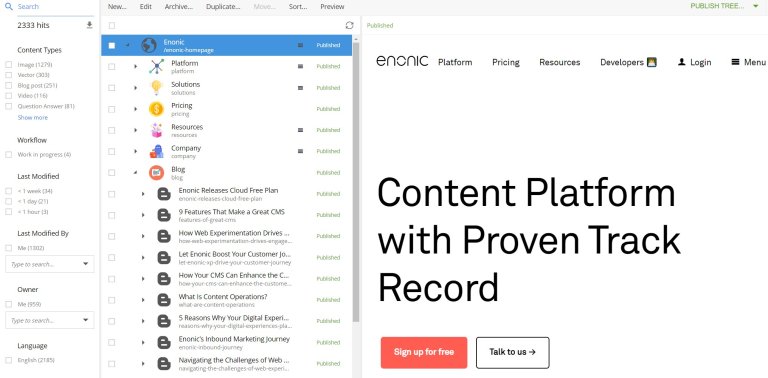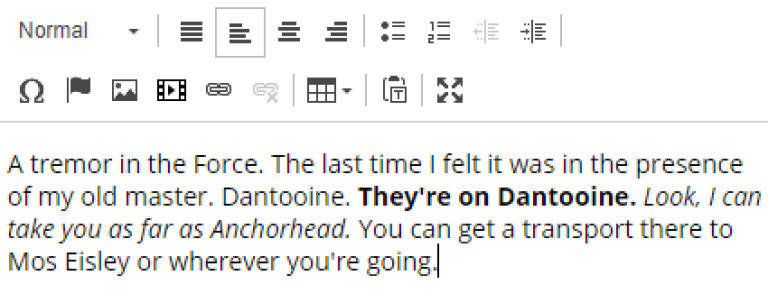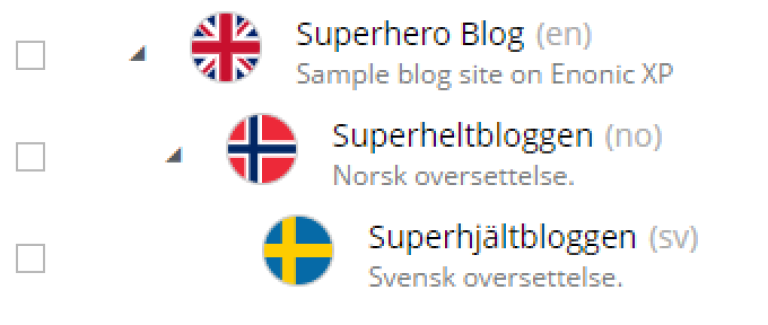What Is Composable CMS?
featureArticle.chapters
featureArticle.introduction
The emergence of composable architecture heralds an exciting era for content management systems (CMS).
Digital businesses deliver content and services in different ways, but the particular alternative of ‘composable’ seems to steadily carve its way to the throne. The advantages? A more flexible way to handle requirements and technological innovations—now and tomorrow.
The CMS industry has bounced between monolithic and decoupled systems, each with its strengths and limitations. However, the growing need for agility and integration of digital technologies has led to the rise of a new heir apparent: the composable CMS.
Distinct from other CMS types, a composable CMS stands out for its promise to satisfy two groups which historically have been at odds: the content editor and the developer.
Executive Summary
- Composable architectures are essential for keeping pace with technological advancements and market demands by enabling up to 80% faster feature implementation compared to traditional architectures.
- The emergence of composable CMS balances the needs of editors and developers.
- Composable CMS combines headless CMS concepts and traditional CMS capabilities, delivering both an API-first approach and enhanced editor experience.
- It extends beyond headless CMS in content orchestration, server-side customization, integration, and general flexibility.
- Composable CMS bridges services, content management, and front-end presentation to offer a holistic approach to digital content management.
Chapter 1
Why Care About Composable CMS?
In today’s rapidly evolving digital landscape, it is essential to adopt a system that can keep pace with technological advancements and market demands.
This is where the concept of a composable CMS comes into play.
But what exactly makes it so crucial for developers, content editors, and business advisors? Why should organizations care about transitioning to a composable approach?
Accelerating Development and Innovation
A striking prediction by Gartner underscores the potential of composable architectures. By 2023, organizations that had adopted an intelligent composable approach were expected to implement new features 80% faster than competitors sticking to traditional suites.
This staggering difference in speed and agility highlights a critical competitive edge. Keeping up with competitors is just the beginning, as the real impact will come to innovation and user experience.
Headless CMS has been “just another service” in the modern stack and has proven to be suboptimal for websites. Composable CMS, on the other hand, caters to the whole organization by bringing back flexibility for all teams and departments.

Enhanced Agility and Separation of Concerns
Composable follows the headless tradition of separating presentation from content, but with the added bonuses of a more visual editing experience for content editors and the factor that makes a CMS composable: The integration and orchestration of third party services and custom APIs.
This approach enables a welcome separation of concerns. Now front-end developers can work with their preferred tools and dedicate their focus purely to the user experience (UX). Meanwhile, other teams can leverage the division of labor to efficiently handle their respective domains, be it visual content management or back-end development.
Embracing Omnichannel Strategies
In a composable architecture, the core philosophy is to build solutions using the best components from their respective fields. This includes eCommerce, analytics, front-end, CRM, and marketing automation.
The composable approach aligns perfectly with omnichannel strategies. Here the goal is to provide a consistent user experience across various touchpoints. A composable CMS is the perfect match by offering an orchestration layer, ensuring that each aspect of your digital experiences is optimized, leading to a more cohesive customer journey.
The Bottom Line
So, why care about composable CMS? It’s about rapidly adapting and innovating in a digital environment that never stands still. It’s about ensuring that different teams can work in their areas of expertise without bottlenecks slowing down the process.
Most importantly, it’s about embracing a front-end agnostic approach with a CMS capable of managing websites and orchestrating content delivery and integrations. For developers, content editors, and business advisors, composable CMS represents a future proof solution that promises speed, efficiency, and a competitive advantage.
As with other terms in CMS, composable is unfortunately often misused and misunderstood. Similarly to headless, if we don't watch out, it will lose any meaning. This would be sad, because going composable is real progress and holds great promise. Janus Boye, Host, Lead, Coach, Boye & Company
Chapter 2
Historical Background
The history of CMS has been marked by a constant tug-of-war between the needs of editors and developers. This ongoing struggle has shaped the evolution of CMS technologies, leading to the rise of composable CMS.
The Traditional CMS: Editor-Friendly, Developer-Restrictive
In traditional CMS systems like suites and digital experience platforms, the focus was on the content editor. These systems provided a user-friendly environment with access to templates, visual editing tools, and an intuitive interface.
However, this editor-centric approach often left developers constrained. They faced restrictions due to the tightly coupled nature of the CMS and front-end, limiting their ability to use their favorite tools.
The Emergence of Headless CMS: A Developer’s Relief
The introduction of headless CMS marked a significant shift. By decoupling the front-end from the CMS, developers got more flexibility to use their preferred frameworks.
This freedom, however, came at a cost for editors. The user-friendly environment gave way to form editing, with limited options for visual editing, tree structures, previews, and URL management.

Modern Stack Solutions and Limitations
With modern stack solutions that employ headless CMS, the CMS is often reduced to “just another API.” This diminishes its role and practical use cases, which creates challenges for both editors and developers.
The limitations of headless CMS has increasingly become more apparent, and neither traditional nor headless systems seem to ideally cater to the entire digital team within an organization.
Content Federation: a Middleware Solution
Content federation platforms have emerged in an attempt to save organizations stuck in legacy CMSs. They offer page builders linking to content in your existing CMSs and other data sources, acting as an integration API gateway. This allows for building modern stack solutions without replacing your legacy CMS.
However, this middleware approach introduces another layer of complexity. The content federation platform itself represents yet another cog in the machine, requiring updates and maintenance. For editors, it means inefficient workflows, often having to switch between the content federation platform and their CMS, not to mention difficulty in keeping track of what is used where.
Composable CMS: the Ideal Solution
Addressing all of these challenges, composable CMS enters the scene. Unlike a headless CMS, composable CMS recognizes the crucial role of CMS in creating websites and other content savvy digital experiences.
It combines the functions of headless CMS, traditional CMS, and the API gateway of middleware, offering both the editorial functionalities (like tree structure, in-context preview and visual editing), as well as the front-end agnostic and integration capabilities needed by developers.

Chapter 3
Defining Composable CMS
At its core, a composable CMS is, first and foremost, a content management system—designed to manage digital content. Like all CMSs, it serves the primary function of creating, managing, editing, and publishing digital content.

What Sets Composable CMS Apart
The unique characteristics of a composable CMS separating it from all the other types of content management systems, can be understood through its historical context and its contrast to traditional and headless CMS models.
- Decoupled Architecture:
Drawing from the headless approach, a composable CMS also features a decoupled architecture. This means that the content management back-end is separated from the content presentation layer. - Integrations:
A composable CMS can seamlessly connect with various other systems and tools. This allows teams to orchestrate a cohesive digital ecosystem, integrating or delivering services with less code. - Enhanced User Experience for Editors and Developers:
Addressing the historical trade-off between the needs of editors and developers, composable CMS offers solutions that satisfy both. Editors enjoy a user-friendly environment with advanced editing tools, while developers benefit from the freedom to use their preferred technologies and frameworks.
The Comprehensive Definition
Now we are ready for our essential definition of a composable CMS:
A composable content management system organizes the creation, modification, and publication of digital content, and orchestrates the integration between services, content, and presentation.

Composable Architecture vs. Composable CMS
The composable concept is a response to the limitations of previous architectures. As such, a composable architecture refers to a system where every component is pluggable, scalable, replaceable, and can be continuously improved—including the CMS.
Driven by modern API and SaaS trends, this architecture enables organizations to build richer digital experiences more efficiently than traditional stack approaches. It represents a shift from monolithic software suites to a focus on API-first approaches, allowing organizations to choose best of breed solutions from various vendors.
With this in mind, the term ‘composable architecture’ reflects the system as a whole. It is about using various front-ends, APIs, and services in tandem and focusing on the end result.
A CMS is a natural part of a composable architecture. To fit into a composable architecture, the CMS must at least offer headless capabilities through a web API. A composable CMS is simply a CMS that in itself is built with a modular and customizable architecture, a true platform, opting for even more flexibility.
Chapter 4
Beyond Headless
At its essence, a headless CMS is primarily focused on managing and delivering structured content through a web API. This ‘headless’ approach, devoid of a front-end presentation layer, has been a game changer in allowing content to be served seamlessly to various front-end clients.
However, this model often falls short in areas like intricate content organization, where tree structures and visual editing are essential for more sophisticated content management needs. The evolution into a composable CMS begins when these limitations are addressed.
Unlike the headless CMS, a composable system is not just about serving structured content to a separate front-end. Instead, like a traditional CMS it is fully equipped for the management of complete websites, including custom capabilities and modules that go beyond editorial content. This capability represents a significant leap, turning the CMS from a mere content repository into an integral part of the digital experience.
Traditional CMSs could typically sport a multitude of functions. These included form builders, reviews, and several other features lost with the more lightweight headless systems. With composable, these functions can be built into and integrated with the CMS.

Enhanced Capabilities and Flexibility
A composable CMS offers unmatched flexibility, especially in integration, blending various technologies to create a cohesive digital ecosystem. This adaptability is key, allowing the system to meet diverse technology and user needs.
For example, in a healthcare organization, a composable CMS is not limited to managing different content types, from health articles to patient tutorials. It can for instance integrate with medical databases and back user interaction like polls and feedback.
This facilitates not only efficient content management but also a richer, more engaging user experience, enhancing patient education and access to healthcare services.
The Holistic Approach of Composable CMS
A composable CMS represents a holistic solution in the realm of digital content management. It surpasses the headless model by not only enhancing the creation and management of reusable structured content. It also focuses on the end user experience and other requirements and tools to build engaging websites.
Examples of projects that may benefit from both cost and management perspectives are: a marketing team creating landing pages and personalized messaging, an eLearning company blending tests, search, and editorially managed content and navigation, a content-savvy organization curating a digital archive and their website from a single interface, or an eCommerce team controlling landing pages, hierarchies, and editorial content seamlessly integrated with their products.
Its flexible approach makes the composable CMS an invaluable asset in crafting immersive and interactive digital customer journeys. It effectively bridges the gap between services, content management, and front-end presentation.

Chapter 5
Key Elements of a Composable CMS
A composable CMS is characterized by its versatile and multifaceted nature. Now we delve further into the key elements that collectively define what a composable CMS is and how it functions in the digital ecosystem.
Web API: The Communication Backbone
Central to a composable CMS is its web API, often utilizing GraphQL or REST. This API acts as the communication backbone, facilitating interactions between the CMS and various clients or services. It allows for efficient data retrieval and management, ensuring that the CMS can seamlessly integrate and communicate within a diverse digital landscape.

Content Reuse
In a composable CMS, content reuse is a fundamental feature. This allows for the same piece of content to be utilized across different channels and platforms, enhancing consistency and reducing duplication efforts.
Content Aggregation
Alongside reuse, content aggregation can be achieved by delivering content from different sources through a single API.
Advanced Search
The search functionality of a composable CMS is designed to be robust and versatile, catering to complex content queries and organization needs. This advanced search capability improves content discoverability and organization.

Client Diversity
Additionally, the ability to cater to different clients—from web and mobile apps to IoT devices—is a hallmark of a composable CMS. It ensures that content delivery is adaptable and responsive to various platforms.
Rich Text
Rich text handling is another crucial element, providing content creators with powerful tools for text editing and formatting. This feature is essential for crafting engaging and visually appealing content.

Page Composition
Complementing rich text is the page building and composing capability, which allows for the intuitive and dynamic assembly of web pages. This functionality enables users to design and structure web pages with ease, using drag-and-drop interfaces and a variety of templates and components.
System Overview and Dependencies
A composable CMS provides a clear overview of usage and dependencies. This includes understanding what clients are fetching which data and how different content elements relate to and depend on each other. This insight is crucial for managing complex content structures and ensuring consistency and accuracy across the digital ecosystem.
Localization
Localization features cater to different languages and markets, allowing businesses to reach a global audience with tailored content.

Media Management
Media and image handling capabilities ensure that various media types are managed efficiently and optimized for different platforms, ensuring high quality content delivery.
Customizability
The API of a composable CMS is designed to be customizable, aligning with specific business requirements and data structures.
Event Handling
Event handling is also a key component, enabling real-time updates and interactions based on user actions or system triggers.
Cluster Management
For large-scale operations, features like cache invalidation, notification systems, and job triggering are managed both locally and across clusters. This ensures high performance and consistency in content delivery and system operations.
Interface Customization
The back-end interface of a composable CMS is customizable, enhancing usability and efficiency for different user roles.
Integration with Third Party Systems
Integration with third-party systems, such as analytics and SEO tools, is seamless, making the composable CMS a part of a larger digital ecosystem. This integration extends the functionality and efficiency of the CMS, making it a versatile tool in digital content management.
Hierarchical Content Organization
Finally, the ability to manage content in hierarchical tree structures is a significant feature of a composable CMS. This functionality aids in organizing complex content in a navigable and logical manner, crucial for large-scale content strategies.

Chapter 6
Use Cases
The composable CMS is becoming an indispensable tool in modern digital strategies, offering a balanced solution that caters to the entire digital team within an organization.
How can composable CMS best be used by different organizations in different industries? Let’s take a look at some use cases.
Marketing and Websites
Content teams and websites have in many ways been left behind in the developer driven headless craze, but composable CMS steps in to rectify that mistake.
With composable, more or less “traditional” teams, projects, and sites still receive all the benefits from headless CMS, like fast loading, modern user experience, consistent brand and messaging, and developers using their favorite tools and front-ends.
But here’s the sweetener: Content editors and marketers still get to keep the control known from traditional CMS. They can manage tree structures and landing pages, all seamlessly integrated with their favorite marketing tools.

Content Savvy Organization
Beyond traditional marketing websites are the organizations that must handle enormous amounts of complex content, like the financial services industries or the healthcare sector.
These content savvy organizations can use a composable CMS to orchestrate structured content, integrations, and more regular website management.
Whether it's support for an API making their content available for third parties, an integration with a legal text service, or flexible content management, a composable CMS will cover the ground for demanding content teams with an equally demandning industry and subject matter.

Self Service
Imagine a healthcare provider using a composable CMS to integrate various health related content, patient education materials, and interactive tools.
The CMS could seamlessly connect medical databases, editorial content, and customized interactive services, allowing for the secure and efficient presentation of relevant patient health information. The bonus: Everything created can be reused in other channels and services.
The CMS’s ability to handle diverse content types—from health articles and video tutorials to patient testimonials—not only enriches the patient experience but also ensures that information is accessible and engaging. At the same time, everything is orchestrated from a single, intuitive interface.

eCommerce
The realm of eCommerce has also gotten onboard the headless bandwagon, often backed by a headless commerce platform. The same benefits from composable architecture also apply here: blazing speeds, omnichannel presence, front-end agnosticism. All in all greater user experience and flexibility.
However, the same headless challenges apply as well, and that’s why eCommerce companies should put a composable CMS on the top. This setup provides a plethora of flexibility, letting you sew it all together with APIs.
Composable commerce is a sturdy and secure bridge out of the monolithic eCommerce platforms. Composable CMS can orchestrate the customer experience, contributing with everything from landing pages, search, and ratings, without stepping deep into the eCommerce company’s logistics and pricing systems.

Media and Publishing
Historically, the media and publishing industry have already sported reusable content and separate front-ends. This was due to their nature as a multichannel offering long before it became fashionable, first in the form of physical vs, digital content, then in the form of desktop vs. mobile, not to mention reuse across different publications.
Headless has been a natural progression for media corporations, with all the expected and already mentioned benefits. However, with composable CMS added to the mix, journalists and editors can orchestrate different kinds of content and structures beyond the articles, all while having their content fully reusable.

Apps
The development and management of apps have had a most natural relationship with headless CMS since it was technically possible.
A composable CMS can deliver content and other interactive aspects that reside outside of the application’s core functionality, acting like a management back-end for the application. This can for instance be handling feedback or managing translations.
In other words, composable CMS can be used to build custom back-end functionality and admin interfaces to let companies operate their applications in an even more efficient manner.

Chapter 7
Embracing the Future with Composable CMS
It’s clear that composable CMS represents a significant evolution in digital content management. The journey from traditional, editor-centric CMS platforms to the more developer-friendly headless CMS, and ultimately to the uniting composable CMS, highlights the industry’s ongoing efforts to balance the needs of editors, developers, and end users.
The emergence of composable CMS as a holistic solution addresses the historical limitations of its predecessors. It transcends the headless model by not just delivering structured content through APIs, but also by empowering the customer journey. The ability to integrate a myriad of services and technologies makes it a cornerstone for building sophisticated digital ecosystems.

Looking to the future, the prospects of composable CMS are promising. As digital technologies continue to advance and user expectations evolve, the flexibility of composable CMS will become increasingly important. Organizations can expect to deliver more dynamic, adaptable, and user-centered digital experiences, driven by the integration and management capabilities of composable CMS.
In essence, the composable CMS stands as a beacon of innovation in digital content management. As we move forward, the role of composable CMS in shaping digital experiences will undoubtedly grow, making it an indispensable element of any forward-thinking digital strategy.
